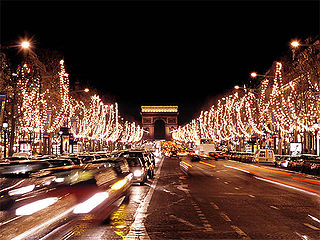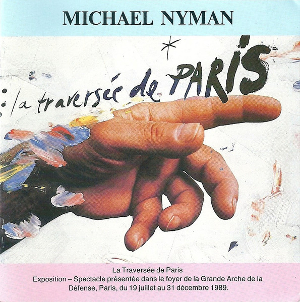
The Arc de Triomphe de l'Étoile is one of the most famous monuments in Paris, France, standing at the western end of the Champs-Élysées at the centre of Place Charles de Gaulle, formerly named Place de l'Étoile—the étoile or "star" of the juncture formed by its twelve radiating avenues. The location of the arc and the plaza is shared between three arrondissements, 16th, 17th (north), and 8th (east). The Arc de Triomphe honours those who fought and died for France in the French Revolutionary and Napoleonic Wars, with the names of all French victories and generals inscribed on its inner and outer surfaces. Beneath its vault lies the Tomb of the Unknown Soldier from World War I.

The Place Charles de Gaulle, historically known as the Place de l'Étoile, is a large road junction in Paris, France, the meeting point of twelve straight avenues including the Champs-Élysées. It was renamed in 1970, following the death of President Charles de Gaulle. It is still often referred to by its original name; the nearby Métro and RER station retains the designation Charles de Gaulle–Étoile. Paris's Axe historique cuts through the Arc de Triomphe, which stands at the centre of the Place Charles de Gaulle.

The Axe historique is a line of monuments, buildings, and thoroughfares that extends from the centre of Paris, France, to the west. It is also known as the Voie Triomphale.

The Avenue des Champs-Élysées is an avenue in the 8th arrondissement of Paris, France, 1.9 kilometres (1.2 mi) long and 70 metres (230 ft) wide, running between the Place de la Concorde in the east and the Place Charles de Gaulle in the west, where the Arc de Triomphe is located. It is known for its theatres, cafés, and luxury shops, as the finish of the Tour de France cycling race, as well as for its annual Bastille Day military parade. The name is French for the Elysian Fields, the place for dead heroes in Greek mythology. It has been described as the "most beautiful avenue in the whole world".

The Place de la Concorde is one of the major public squares in Paris, France. Measuring 7.6 ha in area, it is the largest square in the French capital. It is located in the city's eighth arrondissement, at the eastern end of the Champs-Élysées.

The 8th arrondissement of Paris is one of the 20 arrondissements of the capital city of France. In spoken French, the arrondissement is colloquially referred to as le huitième.

The Arc de Triomphe du Carrousel is a triumphal arch in Paris, located in the Place du Carrousel. It is an example of Neoclassical architecture in the Corinthian order. It was built between 1806 and 1808 to commemorate Napoleon's military victories in the Wars of the Third and Fourth Coalitions. The Arc de Triomphe de l'Étoile, at the far end of the Champs Élysées, is about twice the size; designed in the same year but not completed until 1836.

Ange-Jacques Gabriel was the principal architect of King Louis XV of France. His major works included the Place de la Concorde, the École Militaire, and the Petit Trianon and opera theater at the Palace of Versailles. His style was a careful balance between French Baroque architecture and French neoclassicism.

Avenue Foch is an avenue in the 16th arrondissement of Paris, France, named after World War I Marshal Ferdinand Foch in 1929. Previously it was known as the Avenue du Bois de Boulogne. It is one of the most prestigious streets in Paris, as well as one of the most expensive addresses in the world, home to many grand city palaces, including ones belonging to the Onassis and Rothschild families. The Rothschilds once owned numbers 19–21.

C'était un rendez-vous is a 1976 French short film directed by Claude Lelouch, showing a high-speed drive through Paris.

Impressions de France is a film about France and the featured attraction in the France Pavilion of Epcot's World Showcase at Walt Disney World in Florida. The movie is presented in the Palais du Cinéma building and projected onto five adjacent screens, giving 200° coverage and resembling a Cinerama Screen, in which one giant, curved screen stretches so wide that the edges are at the peripheral vision of the average person, unlike Circle-Vision 360° found at the Canada pavilion and the China pavilion.

The Pont Alexandre III is a deck arch bridge that spans the Seine in Paris. It connects the Champs-Élysées quarter with those of the Invalides and Eiffel Tower. The bridge is widely regarded as the most ornate, extravagant bridge in the city. It has been classified as a French monument historique since 1975.

Champs-Élysées–Clemenceau is a station on Line 1 and Line 13 of the Paris Métro in the 8th arrondissement.

La Traversée de Paris(The Crossing of Paris) is an album by the Michael Nyman Band featuring music composed by Michael Nyman for an audio-visual exhibition of the same name which took place at the Grande Arche de la Défense from July to December 1989 to celebrate the bicentennial of the French Revolution.

Tourism in Paris is a major income source. Paris received 12.6 million visitors in 2020, measured by hotel stays, a drop of 73 percent from 2019, due to the COVID-19 pandemic. The number of foreign visitors declined by 80.7 percent. Museums re-opened in 2021, with limitations on the number of visitors at a time and a requirement that visitors wear masks.

Hôtel de Crillon, A Rosewood Hotel is a historic luxury hotel in Paris which opened in 1909 in a building dating to 1758. Located at the foot of the Champs-Élysées, the Crillon, along with the Hôtel de la Marine, is one of two identical stone palaces on the Place de la Concorde. Since 1900, the French Ministry of Culture has listed the Hôtel de Crillon as a monument historique.

Charles Godefroy was a French aviator who became famous for flying through the Arc de Triomphe in Paris in 1919.

The Cours-la-Reine, also spelled Cours la Reine, is a public park and garden promenade located along the River Seine, between the Place de la Concorde and the Place du Canada, in the 8th arrondissement of Paris. It is one of the oldest parks in Paris, created in 1616 by Queen Marie de Medicis. The further extension of the garden between Place du Canada to Place d'Alma is called the Cours Albert Premier.
This article presents the main landmarks in the city of Paris within administrative limits, divided by its 20 arrondissements. Landmarks located in the suburbs of Paris, outside of its administrative limits, while within the metropolitan area are not included in this article.

On 1 March 1871 the Imperial German Army paraded through Paris to mark their victory in the Franco-Prussian War. The city had been under siege by Prussian forces since September 1870, with Prussia being unified into the German Empire on 18 January 1871. The Armistice of Versailles of 28 January ended hostilities, but the city remained in French hands. Preliminary peace terms were agreed in the 26 February Treaty of Versailles, which allowed 30,000 German troops to occupy Paris from 1 March until the treaty was ratified.




















